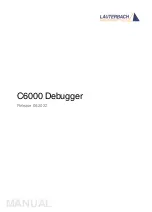
Trigno Quattro, Duo, Mini EMG Sensor User’s Guide
11
Getting Started with the Trigno Sensor
Please refer to the Trigno System User guide for key
operational details regarding the base station, sensor charging,
and initiating the sensor.
Configuring the Trigno Quattro/Duo/Mini Sensors
Once paired to the system, EMG data and IMU data from the sensor can be
configured through the software in the following ways:
Electromyographic (EMG) Sensing Ranges
Input Range
1
11 mV
or
22 mV
Bandwidth
1
20-450 Hz
or
10-850 Hz
RMS Window (optional)
4
100ms
Inertial Measurement Unit (IMU) Ranges
Accelerometer
2
±2
g
or
±4
g
or
±8
g
or
±16
g
Accelerometer Bandwidth
2
24Hz - 470 Hz
Gyroscope
2
±250
dps
or
±500
dps
or
±1000
dps
or
±2000
dps
Gyroscope Bandwidth
2
24 Hz - 360 Hz
Orientation
3
10 Hz
1
EMG range, bandwidth selection and sampling rate are configured by the software.
2
Accelerometer and gyroscope range, bandwidth and sampling rate are configured by
the software.
3
Note that the magnetometer has a fixed range and a fixed bandwidth.
4
An onboard RMS calculation can be invoked to reduce data transmission rates and
maximize bandwidth resources.
Using the Analog Outputs (if Equipped)
The Trigno System provides simultaneous analog signal reconstruction of data
being detected by all active sensors. These signals are made available on the
68-pin connectors located on the Base Station and range cover the +/-5V range.
Analog outputs are engaged through software and are only available for specific
sensor sampling configurations as stated in the sections below:
Quattro Analog Output Configuration
Sensor
Analog Output
Sampling Rate
Data Type
Bandwidth
1
Ch. 1.1,5.1,9.1,13.1
1926 sa/sec
EMG
20-450 Hz
2
Ch. 2.1,6.1,10.1,14.1 1926 sa/sec
EMG
20-450 Hz
3
Ch. 3.1,7.1,11.1,15.1
1926 sa/sec
EMG
20-450 Hz
4
Ch. 4.1,8.1,12.1,16.1
1926 sa/sec
EMG
20-450 Hz
Table 2: “Quattro” Analog Output signal details. Note that sampling rates are
approximate; please refer to specification table for precise sampling periods.












































